MSKLEC_ TMJ
1/97
Earn XP
Description and Tags
keep grinding
Name | Mastery | Learn | Test | Matching | Spaced |
|---|
No study sessions yet.
98 Terms
T or F: TMJ examination should included in any examination of the head , neck, thoracic spine except lumbar.
False, head & neck only
Ailments that can mimic TMJ Disorder:
interrelating factors,
including psychosocial issues.
Oral lesions (e.g., herpes zoster, herpex simplex, oral ulcers)
muscle overuse (e.g., clenching, bruxism)
trauma
systemic lupus erythematosus
RA
headaches
cancer pain
3 cardinal features of TMD are:
Clue: ORN
orofacial pain
restricted jaw motion
joint noise
T or F : The TMJ is a synovial, condylar, modified ovoid, and hinge-type joint with hyaline cartilage surfaces and an articular disc.
False, fibrocartilaginous surfaces rather than hyaline cartilage
Both joints, one on each side of the jaw, must be considered together in any examination.
Trijoint Complex of TMJ
teeth
TMJ on L & R
Movement/s occuring in the upper cavity of the temporomandibular joint:
Movement/s ccurs in the lower cavity of TMJ:
Gliding, translation, or sliding movement
rotation or hinge movement
T or F:
(1)Rotation occurs from the beginning to the endrange of movement.
(2) Rotation occurs through the two condylar heads between the articular disc and the condyle.
False, beginning → midrange
True
The upper head of the lateral pterygoid muscle draws the disc, anteriorly and prepares for condylar rotation during movement.
Both ____ and ____ are essential for full opening and closing of the mouth
gliding & rotation
_________ relation of the jaw and teeth when there is maximum contact of the teeth, and it is the position assumed by the jaw in swallowing.
_________ position in which the teeth are fully interdigitated
Centric occlusion
Median Occlusial Position
TMJ
RPP
OPP
Capsular Pattern
OPP: Mouth slightly open, lips together, teeth not in contact
CPP: Teeth tightly clenched
Capsular Pattern: Limitation of mouth opening
T or F: TMJs actively displace only anteriorly and slightly medially.
When the mouth is opening, the condyles of the joint rest on the disc in the articular eminences, and any sudden movement, such as a yawn, may displace one or both condyles forward.
False, anterior & slightly laterally
READ
As you open the mouth, the condyles displace anteriorly & slight laterally.
The disc is then “seated” on the head of the mandible, and both disc and mandible move forward to full opening.
If this “seating” of the disc does not occur, full range of motion (ROM) at the TMJ is limited.
TMJ Movement: T OR F
(1) In the 1st phase, mainly anterior translation occurs, primarily in the superior joint space.
(2) In the second phase, in which the mandible and disc move together, mainly translation occurs in the inferior joint space.
False, 1st phase → rotation → inferior joint space
False, 2nd phase → superior joint space
________ is Referred to as the skeleton of the tongue.
attachment for the extrinsic tongue muscles and infrahyoid muscles and,
provides ______ stabilization during swallowing
It can affect the. ____ & ____ functions/ regions
hyoid bone
provides reciprocal stabilization during swallowing
Shoulder & cervical functions
Innervation of TMJ?
Branches of the auriculotemporal nerve & masseteric branches of the mandibular nerve
It restrains movement of the lower jaw and prevents compression of the tissues behind the condyle.
temporomandibular, or lateral, ligament
Ligaments that act as “guiding” restraints to keep the condyle, disc, and temporal bone firmly opposed.
Sphenomandibular & stylomandibular joint
Stylomandibular joint is a specialized band of deep cerebral fascia with thicken- ing of the parotid fascia.
Nice to Know
Humans have 20 temporary/ deciduous teeth
32 permanent teeth
Temporary teeth shed between 6-13 years
Adults
Incisors → cut food (front teeth)
Canine teeth → cut & tear food ( 2 maxillary & 2 mandibular)
longest permanent teeth
Premolars → crush and break down the food for digestion
8 overall ( 2 on each side, top & bottom
Final set of teeth
molars → crush and grind food for digestion ( 8 - 12)
3rd molars are called wisdom teeth.
Teeth are divided into 4 quadrants—upper left, upper right, lower left, and lower right
Factors that can lead problems to TMJ
Missing teeth
abnormal tooth eruption
malocclusion
dental caries (decay)
magtooth brush ka kasi
T or F : Signs and symptoms of TMJ dysfunction include facial pain, ear discomfort, headache, neck pain and jaw discomfort.
False, NO NECK PAIN
facial pain, ear discomfort, headache & jaw discomfort only
T or F : Pain in the fully opened position ( opening to bite an apple, yawning) is probably caused by an extra-articular problem
True
T or F : Pain associated with biting firm objects (eating/dynamic loading)is probably caused by an intra-articular problem.
True
T or F : Limited opening may be due to displacement of the disc anteriorly, inert tissue tightness, or muscle guarding.
False, displacement of disc ANT , inert tissue tightness or muscle SPASM
T or F : Restriction can lead to depression in patients because of its effect on everyday activities
False, anxiety lang
T or F: Loss of molars or worn dentures can lead to loss of vertical dimension, which can make chewing painful.
(Vertical dimension : distance between any two arbitrary points on the face, one of these points being above and the other below the mouth, usually in midline.)
True
T OR F: Often, chewing on 1 side is result of malocclusion/ bad bite.
True
A history of stiffness on waking with pain on function that disappears as the day goes on suggests _______.
OA
Normal breathing is through the ___ with the lips ___ and no “air gulping.”
If the patient is a “______” the tongue does not sit in the proper position against the palate.
nose → lips closed
mouth breather → tongue not in. the proper position
T or F: In the young, if the tongue does not push against the palate, developmental abnormalities may occur, because the tongue normally provides internal pressure to shape the mouth.
True
____ & ______ muscle complex provides external pressure to counterbalance the internal pressure of the tongue.
Buccinator & Orbicularis Oris
T or F: Loss of normal neck balance often results in the individual becoming a mouth breather and an upper respiratory breather, making greater use of the accessory muscles of respiration.
True
Adenoids, tonsillitis, and upper respiratory tract infections may cause the same problem.
T or F: Normally, the condyles of the TMJ slide out of the convexity and onto the rim of the disc.
False, slide out of the concavity
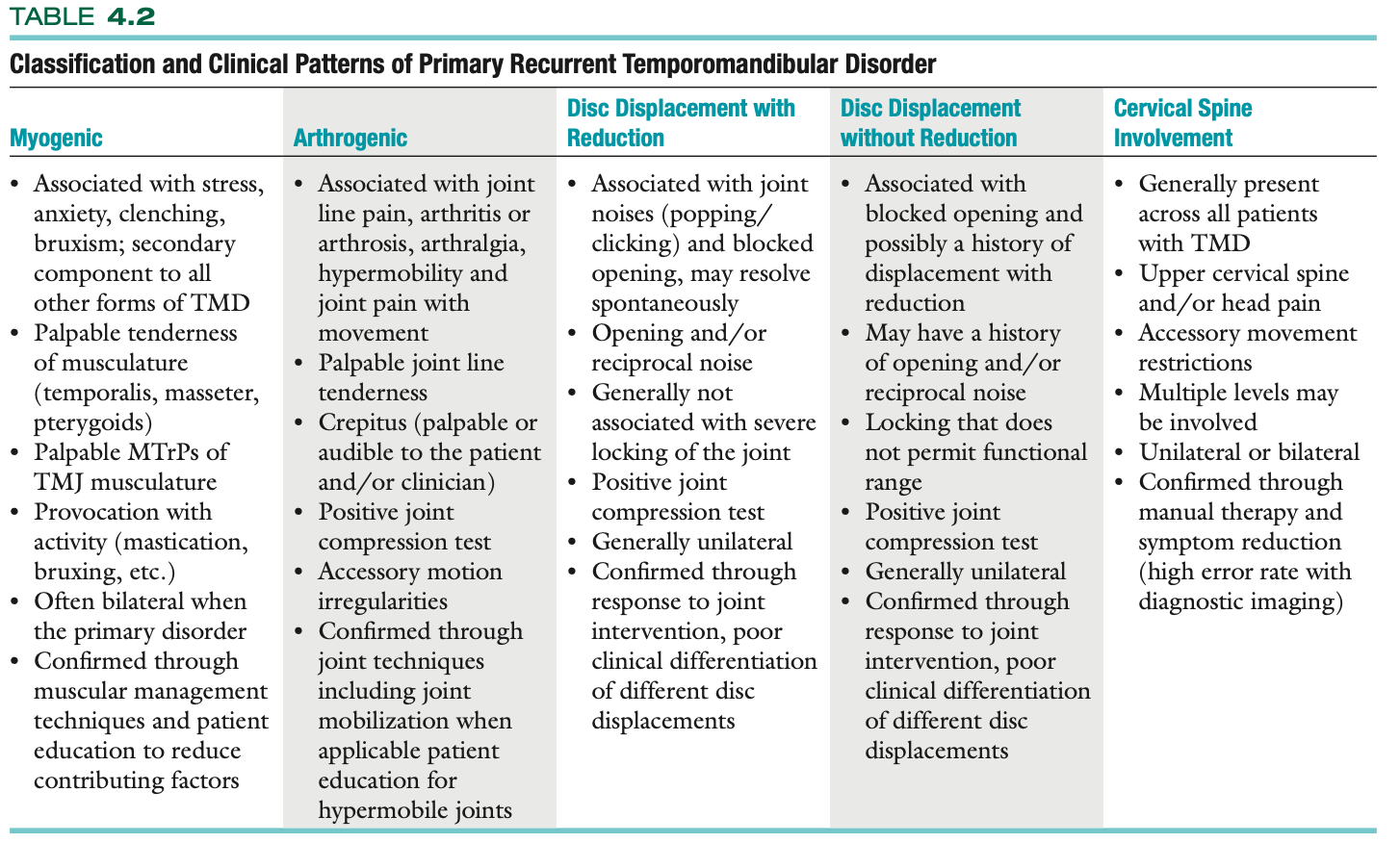
Classification and Clinical Patterns of Primary Recurrent Temporomandibular Disorder
Conditions That May Mimic Temporomandibular Disorders
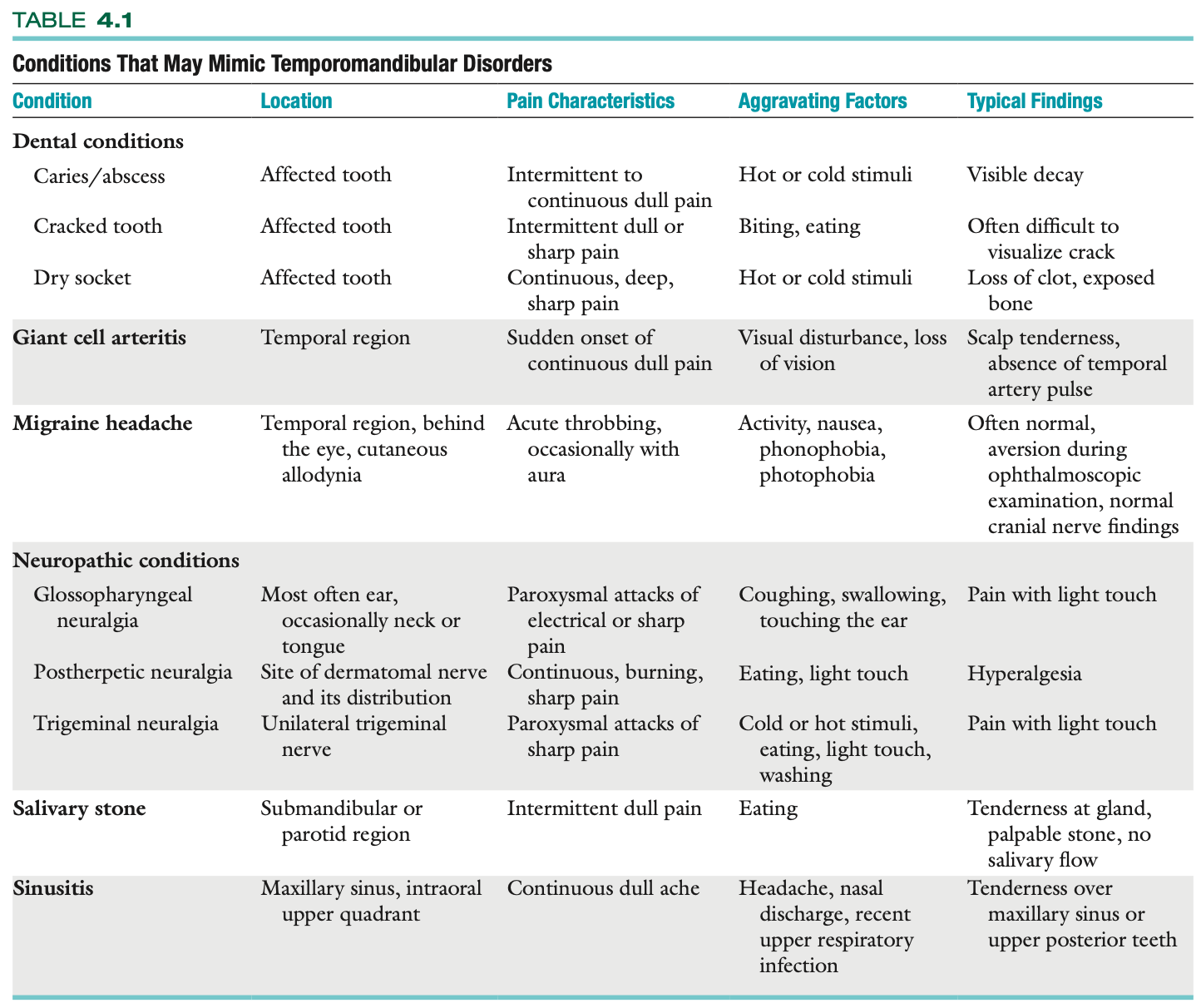
_______ is the result of abnormal motion of the disc and mandible
Clicking
Early clicking implies a developing dysfunction, whereas late clicking is more likely to mean a chronic problem.
Causes of Clicking
condyle slides back off the rim into the center
disc sticks or is bunched slightly
opening causes the condyle to move abruptly over the disc and into its normal position, resulting in a single click on opening
Partial ANTERIOR displacement (subluxation) or dislocation of the disc
Clicking can also happen when disc is displaced anteriorly and/or medially causing the condyle to override the posterior rim of the disc later than normal during mouth opening
T or F
Clicking in closing → disc displacement with reduction
Clicking in CLOSING & OPENING → reciprocal clicking
True
Read
The opening click occurs at some point during the opening or protrusive path, indicating that the condyle is slipping over the thicker posterior border of the disc to its position in the thinner middle or intermediate zone.
The closing (reciprocal) click occurs near the end of the closing or retrusive path as the pull of the superior lateral pterygoid muscle causes the disc to slip more anteriorly and the condyle to move over its posterior border.
Clicking may also be caused by adhesions like _______ ( clenching of teeth especially when sleeping)
Bruxism
T or F:
These “adhesive” clicks occur in isolation, after the period of clenching. If adhesions occur in the superior or inferior joint space, translation or rotation will be limited.
This presents as a temporary closed lock, which then closes with a click.
False, temporary closed lock → opens with a click
T or F
If the articular eminence is abnormally developed (i.e., short, steep posterior slope or long, flat anterior slope), the maximum anterior movement of the disc may be reached after maximum translation of the condyle has occurred.
As the condyle overrides the disc, a loud crack is heard, and the condyle-disc leaps or jogs (subluxes) forward
False, max anterior movement before max translation of condyle
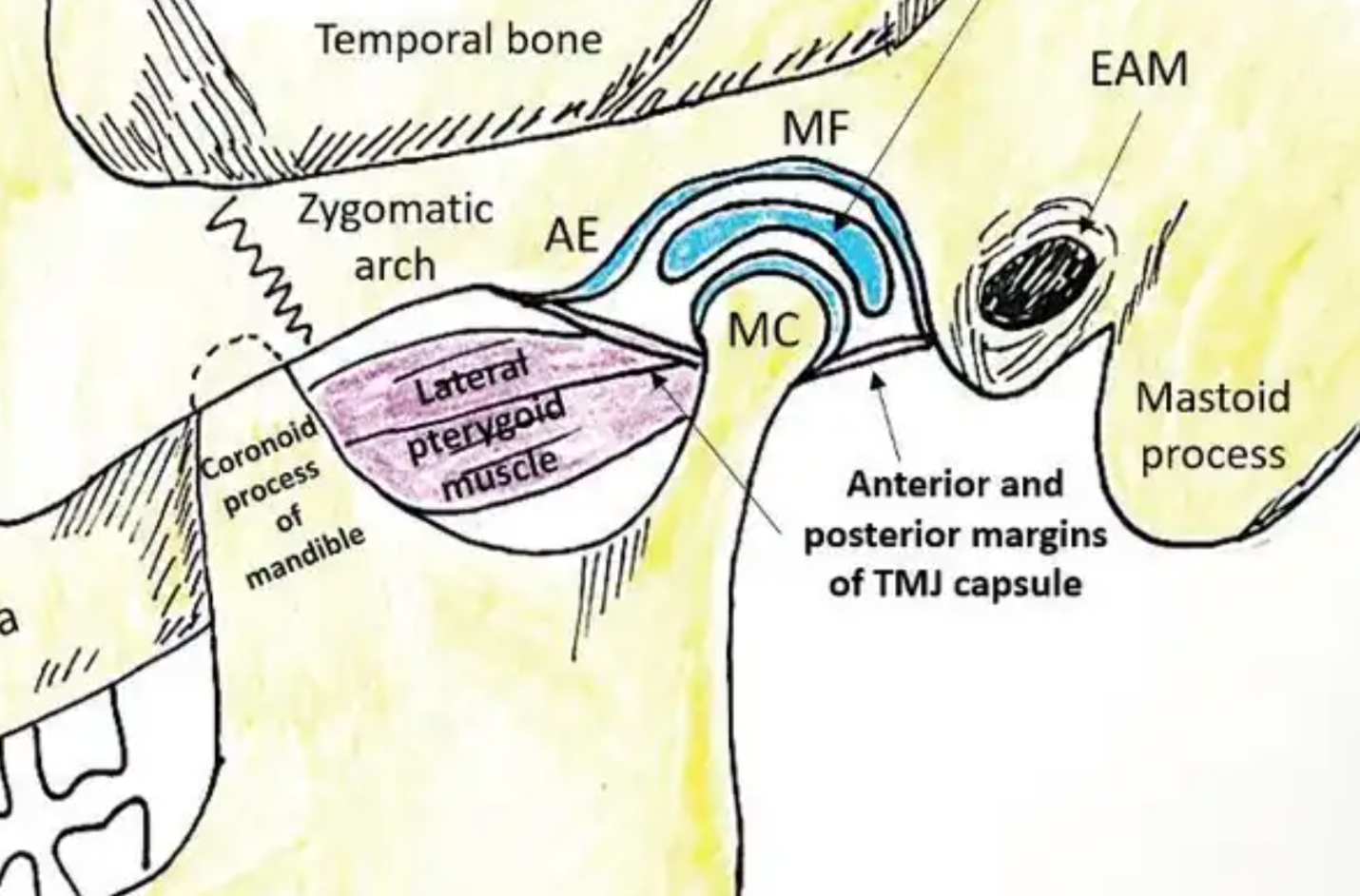
T or F:
Hard or cracking clicks heard in normal joints are caused by ligament movement, articular surface separation, or sucking of loose tissue behind the condyle as it moves forward.
This usually result to muscle incoordination
False, soft or popping clicks
“Hard” or “cracking” clicks are more likely to indicate joint pathology or joint surface defects.
T or F:
Soft crepitus occurs in symptomless joints and is not necessarily an indication of pathology.
Hard crepitus is indicative of arthritic changes in the joints
Caused by uncoordinated muscle action of Lateral pterygoid ,
a tear or perforation in the disc
osteoarthrosis
occlusal imbalance
TRUE
T or F
Normally the LOWER head of the lateral pterygoid muscle pulls the disc forward. If the disc does not move first, the condyle clicks over the disc as it is pulled forward by the UPPER head of the lateral pterygoid muscle.
False,
Upper head → pull disc forward
Lower head → pulls condyles forward if disc does not move first = clicking
T or F
______ lock if mouth does not fully open
_____ lock if mouth foes not fully close
( closed or open lock)
Locking is usually preceded by reciprocal clicking
Closed lock → mouth does not fully open
Open lock → mouth foes not fully close
Often related to problems of the disc or joint degeneration.
Jaw locked in closed position → caused by a disc with the condyle being _____ or _____ to the disc.
posterior or anteromedial
Even if translation is blocked (e.g., “locked” disc), the mandible can still open __ mm by rotation.
30mm
If there is functional dislocation of the disc with reduction , the disc is usually positioned ______ and opening is limited.
anteromedially
Patient complains that the jaw “catches” sometimes, so the locking occurs only occasionally
If there is functional anterior dislocation of the disc without reduction, a ____ lock occurs.
In this case, opening is limited to about ___ mm ( mandible deviates to the affected side and lateral movement to the uninvolved side is reduced )
Closed lock
May anterior and/or medial displacement of the disc = disc does not return to its normal position during entire movement of condyle
25 mm
Most Painful Stage of Temporomandibular Disc Dysfunction
Stage 3
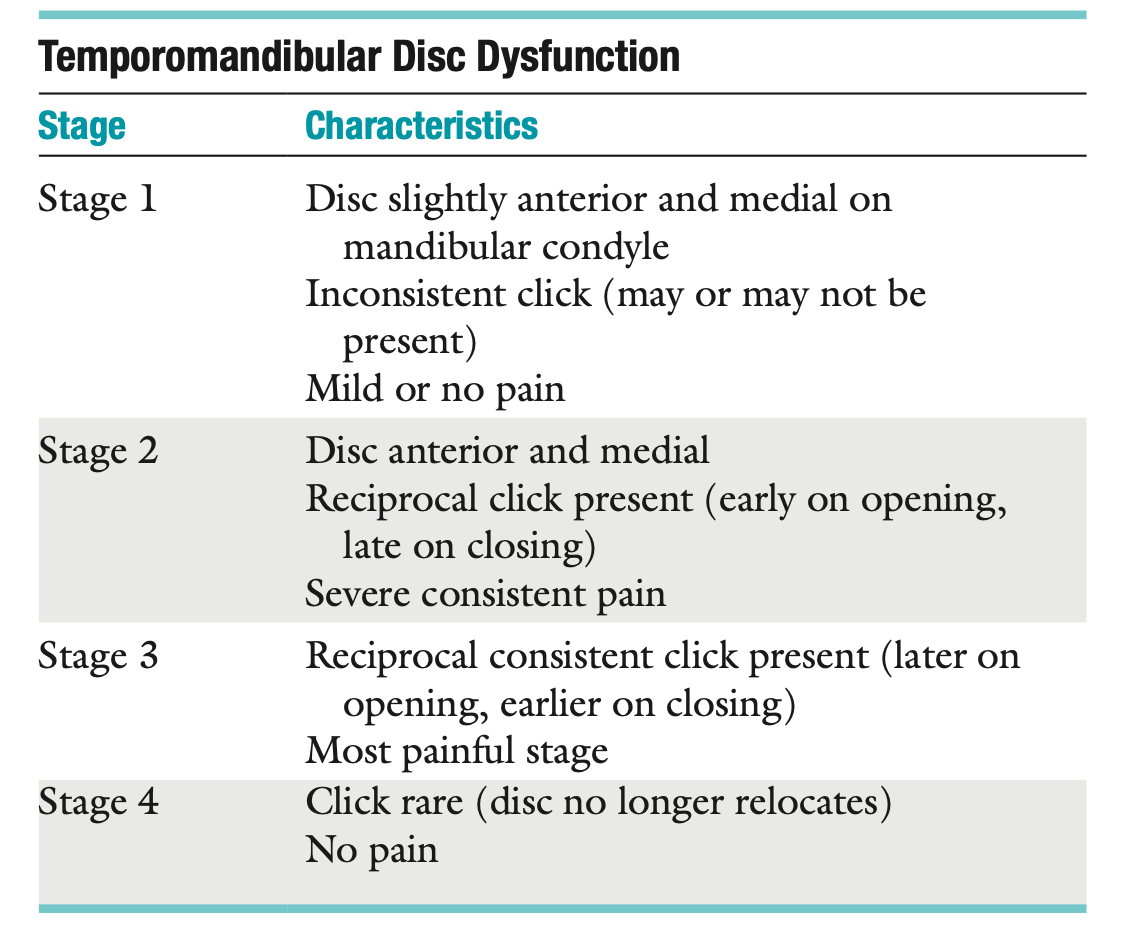
T or F: If locking occurs in the open position, it is probably caused by subluxation of the joint or possibly by anterior disc displacement.
False, posterior disc displacement
T or F:
With an OPEN lock, there are 2 clicks on opening
when the condyle moves over the posterior rim of the disc
when it moves over the anterior rim of the disc
True
If, after the second click occurs on opening, the disc lies posterior to the condyle, it may not allow the condyle to slide back.
If the condyle dislocates outside the fossa, it is a ______ with ___ lock ; the patient cannot close the mouth, and the dislocation must be reduced.
true dislocation with open lock
TMJ Stressors
smoking a pipe or using a cigarette holder
leaning on the chin
chewing gum
biting the nails
chewing hair
pursing and chewing lips
continually moving the mouth, or any other nervous habits
Tooth pain may lead to incorrect biting when chewing
It is a forced clenching and grinding of the teeth, especially during sleep.
May lead to facial, jaw, or tooth pain or headaches in the morning along with muscle _____. ( atrophy or hypertrophy?)
Bruxism → hypertrophy
T or F:
If the front teeth are in contact and the back ones are not, facial and temporomandibular pain may develop as a result of malocclusion.
TRUE
Normally the upper teeth cover the upper third to half of the bottom teeth
TMD related psychosocial issues.
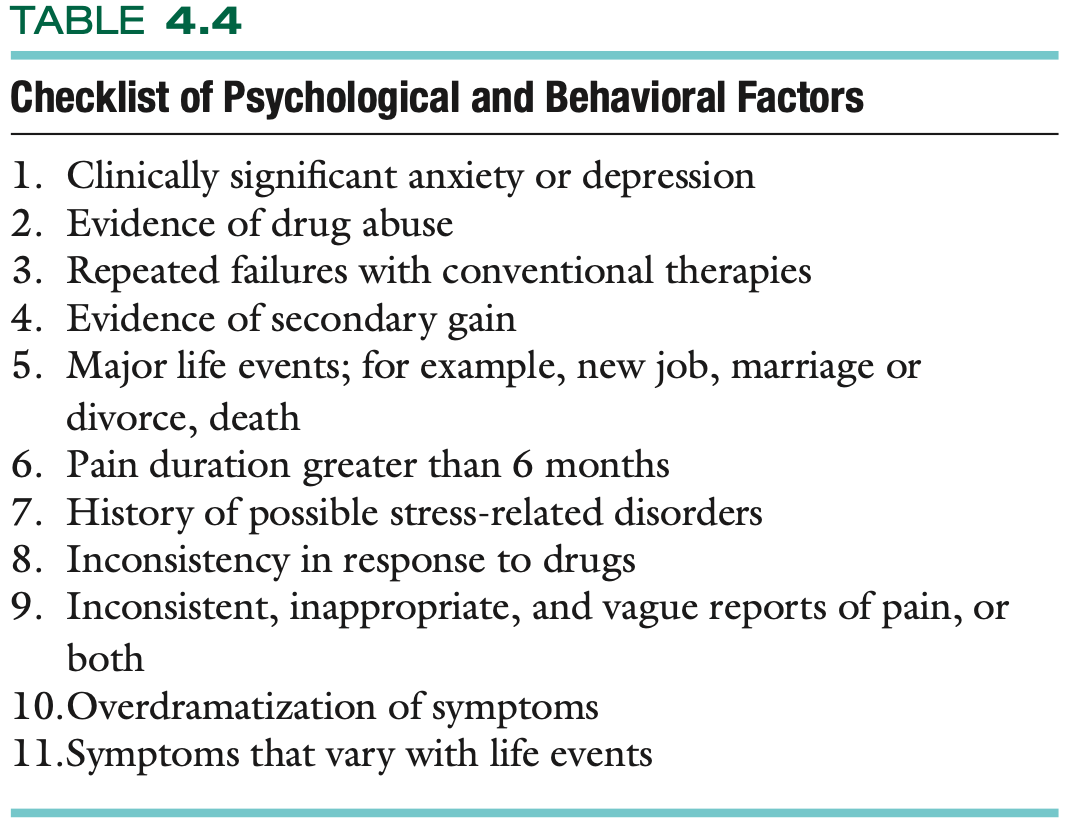
Loss of 1 or more teeth is called _______
partial edentulism
may cause occlusion = TMJD
_____ & _____ nerves control facial expression and mastication and contribute to speech, also control anterior lip seal.
Normal RPP of tongue:
Position in which one would place the tongue to make a “clicking” sound.
facial nerve (CN VII) & trigeminal nerve (CN V)
Against the anterior palate
If lip seal is weakened, the teeth may move anteriorly, an action that would be accentuated in “tongue thrusters.”
Symptoms caused by inner ear, cervical spine , vestibular dysfunction or TMJ
hearing loss
ringing in the ears
blocking of the ears
earache
dizziness
T or F :
Holding the telephone between the ear and the shoulder compacts the TMJ on that side.
Reading or listening to someone while leaning one hand against the jaw has the same effect.
True
T or F :
TMJ problems can refer pain to the head and cervical spine
True
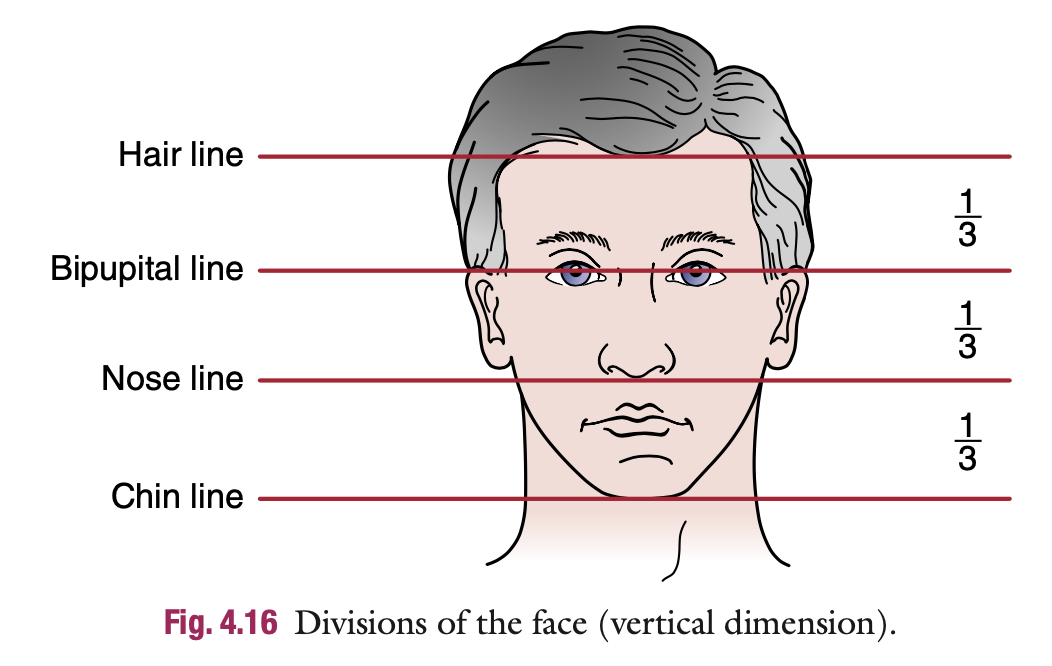
Observation
face should be symmetrical
check the eyebrows, eyes, nose, ears, length of mandible from center line, and distance from the nasolabial folds to the corners of the mouth
Horizontally, the face of an adult is divided into thirds (Fig. 4.16); this demonstrates normal vertical dimension.
Upper & lower teeth are used to measure vertical dimension
The horizontal bipupital, otic, and occlusive lines should be parallel to each other
Loss of teeth on one side can lead to convergence in which at least two of the lines may converge because the jawline is short on one side relative to the other.
Measure the vertical dimension (quick way; equal measurements dapat)
lateral edge of the eye to the corner of the mouth
from the nose to the chin
If the 2nd measurement is smaller than the first by 1 mm or more, there has been a loss of vertical dimension → loss of teeth, overbite, or TMJ dysfunction.
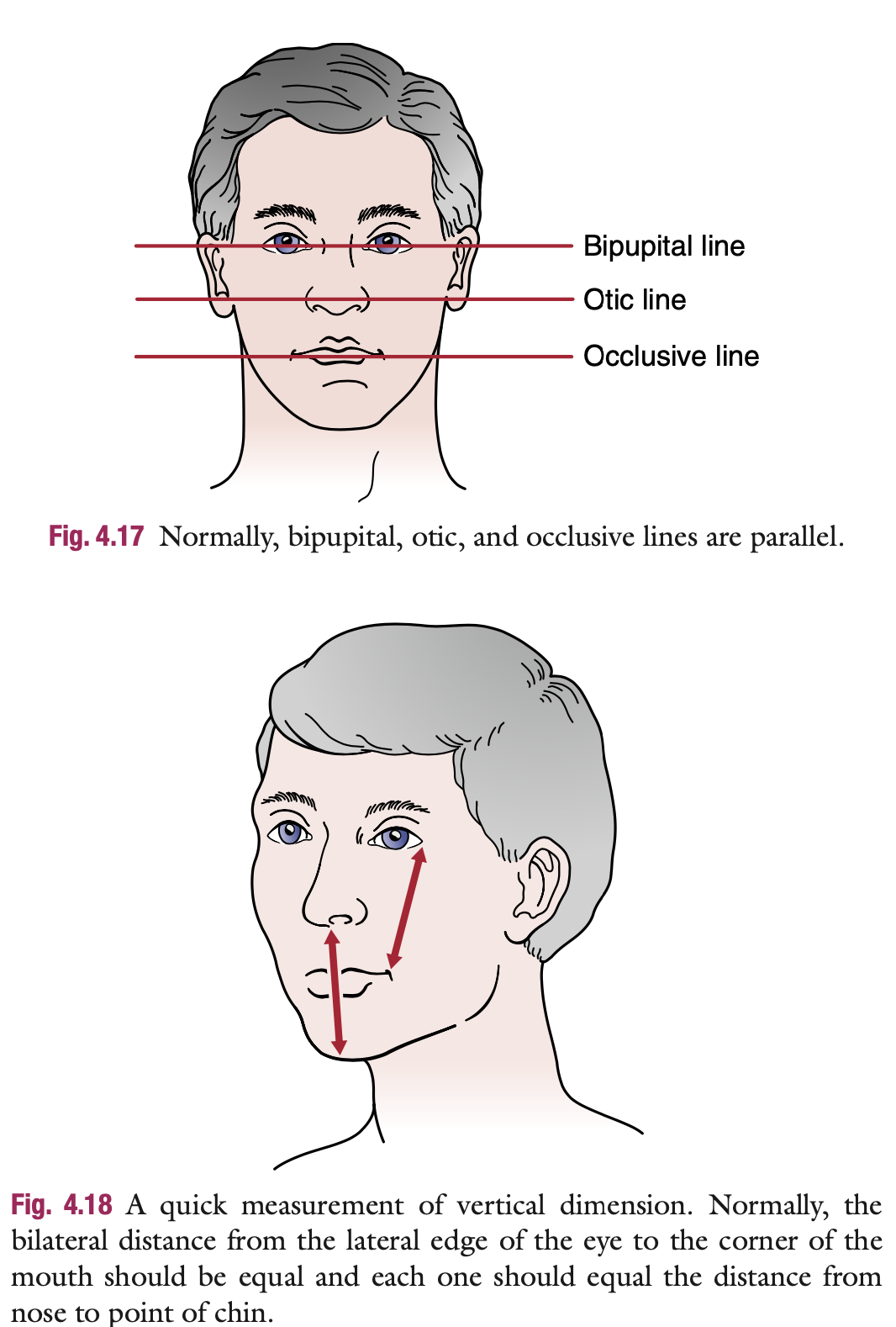
Observation
In children, elderly persons, and those with massive tooth loss, the lower third of the face is not well developed (lack of teeth) or has recessed .
As the teeth grow, the lower 3rd develops into its normal proportion.
Check for ptosis (drooping of an eyelid) or by drooping of the mouth on one side (Bell’s palsy).
Crossbite → teeth of the mandible are lateral to the upper (maxillary) teeth on one side and medial on the opposite side.
Anterior crossbite → the lower incisors are ahead of the upper incisors
Posterior crossbite → there is a transverse abnormal relation of the teeth.

Observation
Underbite: Mandibular teeth are in buccoversion (anterior to maxillary teeth), either unilaterally, bilaterally, or in pairs.
Overbite: Maxillary incisors extend below mandibular incisors when the jaw is in centric occlusion
Normal overbite: 1 to 2 mm, with upper teeth slightly ahead of lower teeth due to the longer maxillary arch..
Overjet: The distance maxillary incisors close over mandibular incisors, normally 2 to 3 mm.
Occlusal interference: Premature contact of teeth that deflects the jaw laterally or anteriorly.
Orthodontic appliances or false teeth: Should be evaluated for proper fit and potential sore spots.
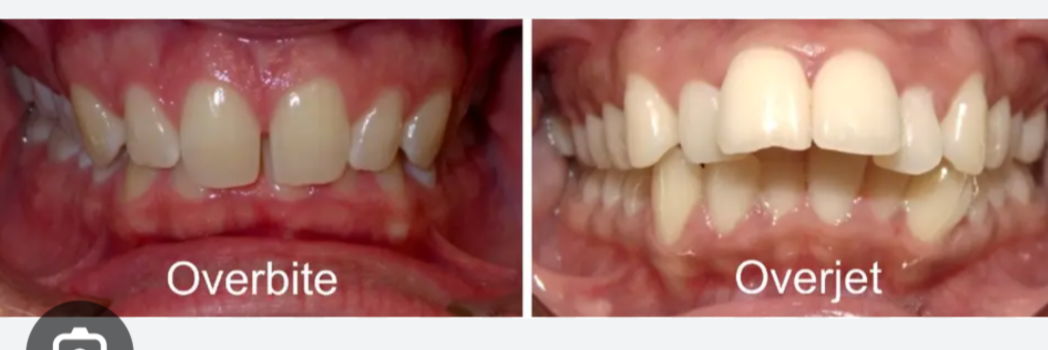
Observation
Note for any malocclusion ( deviation from normal bite)
major factor in the development of disc problems of the TMJs
Class I occlusion: Normal anteroposterior relationship of maxillary and mandibular teeth.
Class I malocclusion: Slightly larger overjet affecting only the incisors.

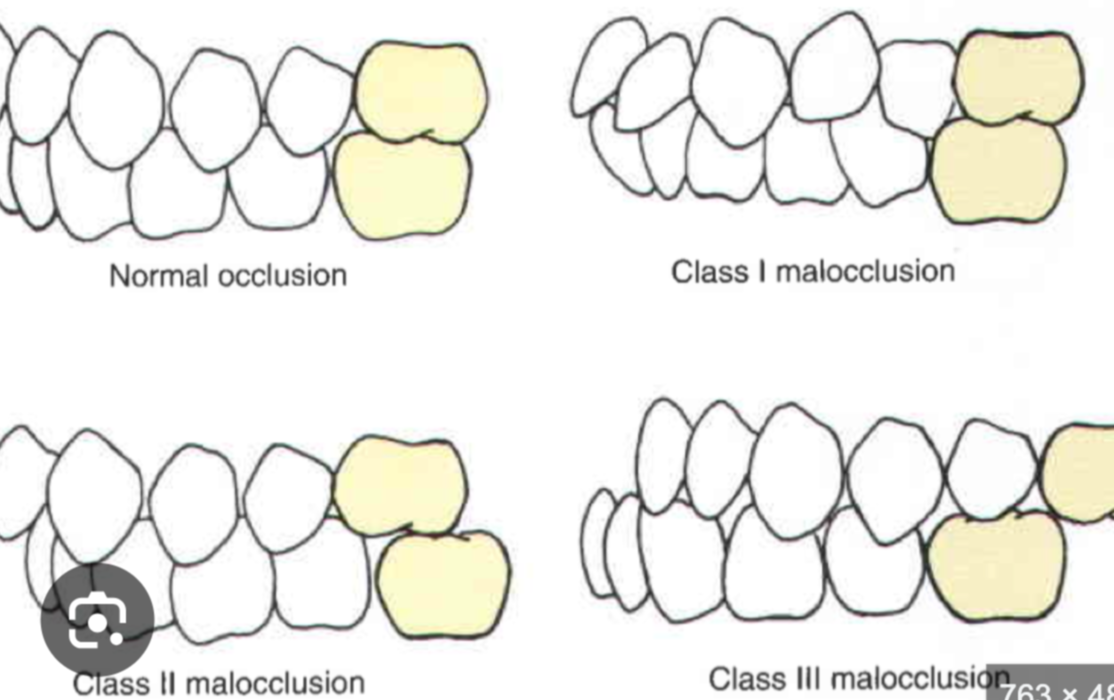
Class II malocclusion (overbite): Mandibular teeth are posterior to their normal position relative to maxillary teeth; affects all teeth, including molars.
Class II Division 1: Significant overjet (large horizontal overlap of maxillary incisors).
Class II Division 2: Overbite with lateral flaring of lateral maxillary incisors, but no significant overjet.
Class III malocclusion (underbite): Mandibular teeth are anterior to their normal position relative to maxillary teeth.
If maxillary and mandibular teeth are on the same vertical plane, a Class III malocclusion is present.
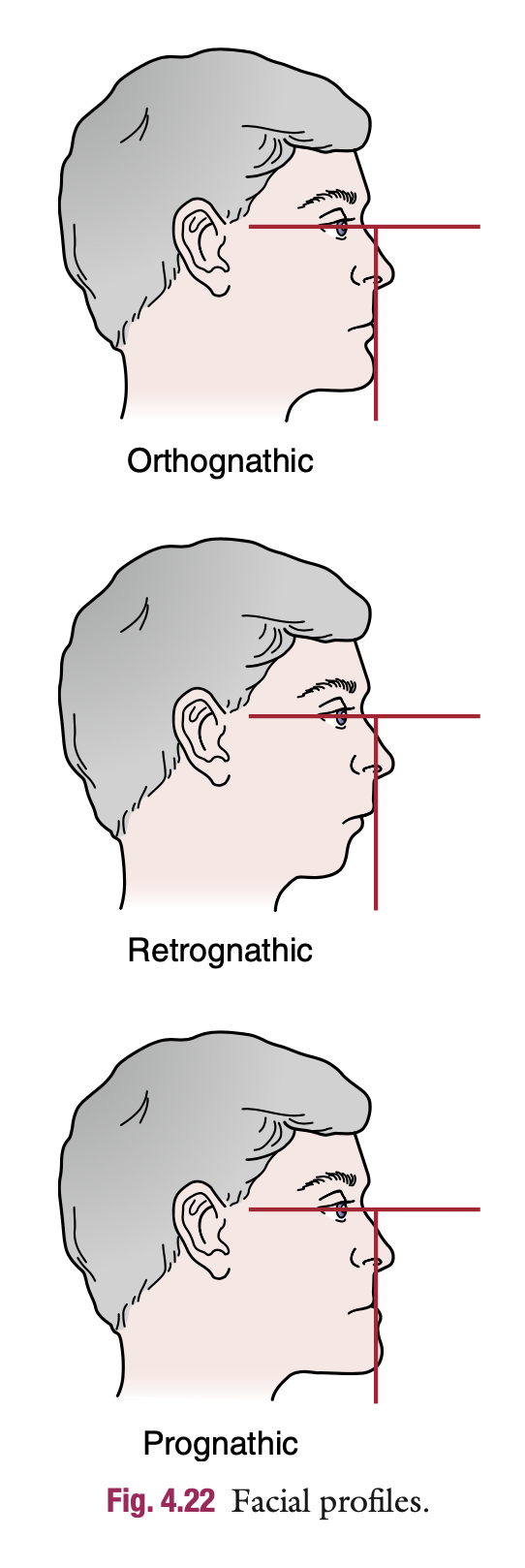
Facial Profile:
Normal Orthognathic profile is
normal, “straight-jawed” form
a vertical line dropped perpendicular to the bipupital line would touch the upper and lower lips and the tip of the chin
Facial Profile:
_________ : chin would lie behind the vertical line and the person would be said to have a “receding chin.”
__________ : chin would be in front of the vertical line and the person would have a protruded or “strong” chin
Retrognathic
Prognathic

Observation
Masseter hypertrophy/bulging when biting down is caused by overuse may lead to abnormal wear of the teeth.
upper lip should normally cover two-thirds of the maxillary teeth at rest.
If it does not, the lip is said to be short.
If the lip can be drawn over the upper teeth → it is functional and no treatment is necessary.
The lower lip normally covers the mandibular teeth and, when the mouth is closed, part of the maxillary teeth.
Observation
Can the patient move tongue properly?
Restriction may be caused by the small fold of mucous membrane ( lingual frenulum)
Can the tongue be protruded or rolled? Is the patient able to “click” the tongue?
________ refers to forward movement of the tongue, usually to push against the lower
also occurs when the tongue is pushed against the upper teeth and the lower teeth are closed firmly against it.
Tongue thrusting: Easier when the head is protruded.
Testing for tongue thrusting:
Correct the patient’s head posture.
Ask the patient to swallow.
Tongue thrusters will move the tongue forward, causing head protrusion during swallowing.
Possible cause: Hyperactivity of masticatory muscles.
Normal swallowing: Hyoid bone moves up and down quickly.
Signs of tongue thrust:
Hyoid bone moves upward slowly.
Posterior contraction of suboccipital muscles.
AROM
Neck flexion:
Mandible moves ___ and ____.
____ neck structures become tight.
Neck extension:
Mandible moves ____ and ___.
_____ neck structures become tight.
Neck flexion:
Mandible moves up and forward.
Posterior neck structures become tight.
Neck extension:
Mandible moves down and back.
Anterior neck structures become tight.
FLEXION/EXTENSION AROM
Examiner's observation:
Check if the patient can flex and extend the neck while keeping the mouth closed or if the mouth must open during these movements.
Test movement:
Patient places a fist under the chin and opens the mouth while keeping the lower jaw against the fist.
If the mouth opens, neck extension is occurring due to head rotation on the temporomandibular condyles.
Important if the patient reports a loss of neck extension.
Side flexion of the neck:
Flexion to the right causes maximal occlusion on the right.
Side flexion and rotation occur to the same side (e.g., both to the right result in maximal occlusion on the right).
Movements of mandible can be measure by :
milimeter ruler, depth gauge, or Vernier calipers.

Normal movement of jaw in opening & closing
smooth & unbroken
(TMJs are working in unison with no asymmetry or sideward movement, and both joints are bilaterally rotating and translating equally)
Normal mandibular opening:
> ___ to ___ mm.
Chewing requires about ___ mm of opening.
> 30-35 mm
18mm
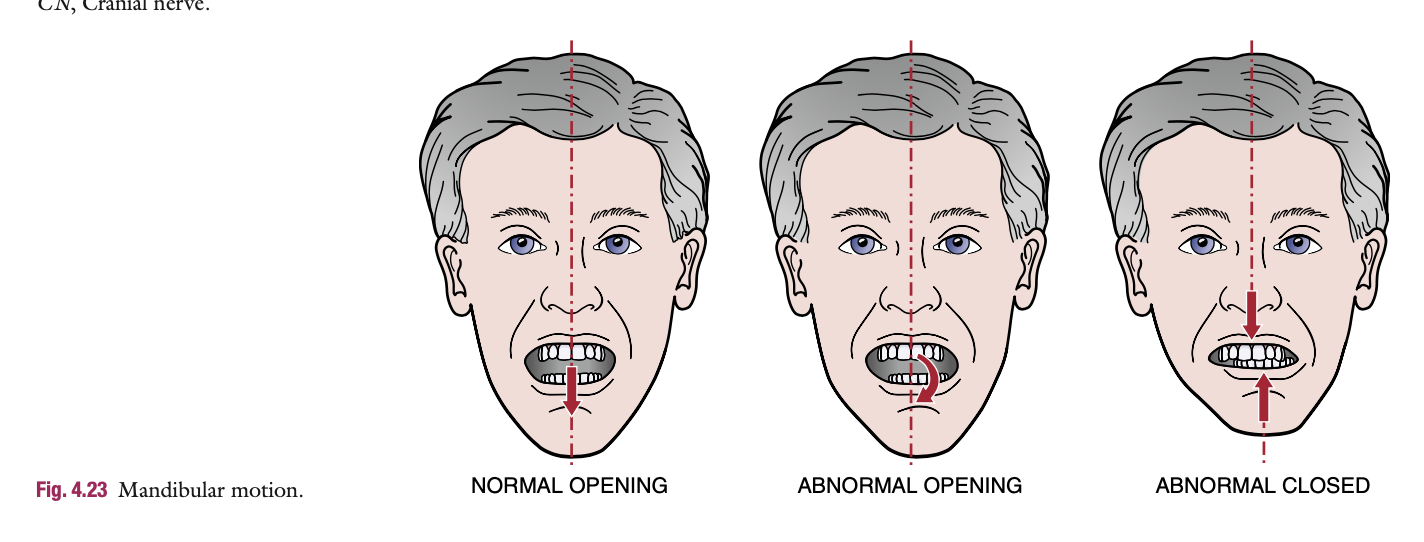
AROM : Phases of mouth opening:
First phase: Rotation of the mandible.
Tested by having the patient open their mouth widely while keeping the tongue against the hard palate.
Minimal pain, even with acute TMJ dysfunction.
Second phase: Translation and rotation.
Begins when the tongue loses contact with the roof of the mouth.
Most clicking occurs during this phase as the condyles move along the eminence slope.
Muscles involved:
_______: Primary muscle for opening the mouth and key in protrusion and medial/lateral deviation of the jaw.
______, _____, and _____ pterygoids: Primary muscles for closing the mouth.
Open → lateral pterygoid
Close → Temporalis, masseter, and medial pterygoid
AROM : OPEN & CLOSE MOUTH
_______ : Refers to the linear tracking of the mandible during movement.
Each movement is done at least __ times to determine whether any deviation is present with each repetition
(enable PT to find out whether the deviation is due to muscular, neuromuscular, or mechanical dysfunction)
Mandibular gait → at least 3 times
Mandibular Motion
______ curve : deviation or deflection occurs to the left on opening
_______ curve : deviation or deflection occurs to the right on opening
hypomobility is evident toward the side of the deviation caused either by a displaced disc without reduction or unilateral muscle hypomobility
C type curve
Reverse C type curve
Mandibular Motion
if the deviation is an S-type or reverse S-type curve, the problem is probably ______ imbalance or ____ displacement as the condyle “walks around” the disc on the affected side.
The chin deviates toward the _____ side due to spasm of the pterygoid or masseter muscles or an obstruction in the joint.
muscular imbalance or medial displacement of condyle
chin deviates toward the affected side
Mandibular Motion
If there is deviation to one side that does not return to midline, it is due to _____ or _____
___ deviation on opening: Typically caused by muscle spasm.
____ deviation on opening: Usually results from capsulitis or a tight capsule.
_____ capsulitis : Pain or tenderness on closing
muscle spasm or adhesions
Early deviation on opening
late deviation on opening
Posterior capsulitis
The functional or full active opening is determined by
having the patient try to place ___ or __ flexed PIP within the mouth opening
Approximately __ to _ mm
Only about __ to __ mm of opening is needed for everyday activity.
2 or 3 flexed PIP
35-55 mm
25-35mm
If the patient has pain on opening, the examiner should also measure the amount of opening to the point of pain and compare this distance with functional opening.
If the space is less than this, the TMJs are said to be _____. (hyper/ hypomobile ?)
hypomobile
Read page 257
Read page 257
AROM: Protrusion of the Mandible
normal movement is more than ___ mm
AROM: Retrusion of the Mandible
normal movement is _- _ mm
AROM : Excursion /Lateral Deviate of Mandible
normal value is _-_mm
> 7mm ( 6-9 mm norkin)
3-4 mm ( norkin wala ata)
10-15 mm
T OR F:
Any lateral deviation from the normal opening position or abnormal protrusion to one side indicates that the lateral pterygoid, masseter, or temporalis muscle, the disc, or the lateral ligament on the opposite side is affected.
True
AROM: Mandibular Measurement
Measurement procedure:
Measure the distance from the posterior aspect of the TMJ to the notch of the chin.
Measure both sides and compare for equality.
Normal distance:
10 to 12 cm.
Significance of differences:
Any disparity may indicate a developmental problem or structural change, leading to left or right convergence.
The patient may struggle to achieve midline balance.
AROM: Swallowing and Tongue Position
Patient instruction:
The patient is asked to relax and then swallow, leaving the tongue in the position it assumes during swallowing (normally close to the roof of the mouth).
Examiner observation:
The examiner, wearing gloves, separates the lips to note the tongue's position (e.g., between the teeth or at the upper anterior palate).
Additional observation:
The examiner can observe the action of the supra-hyoid muscles during swallowing.
Cranial Nerves Testing
If injury to the cranial nerves is suspected, these nerves should be tested.
CN 5,7, 9,10, & 12 are important
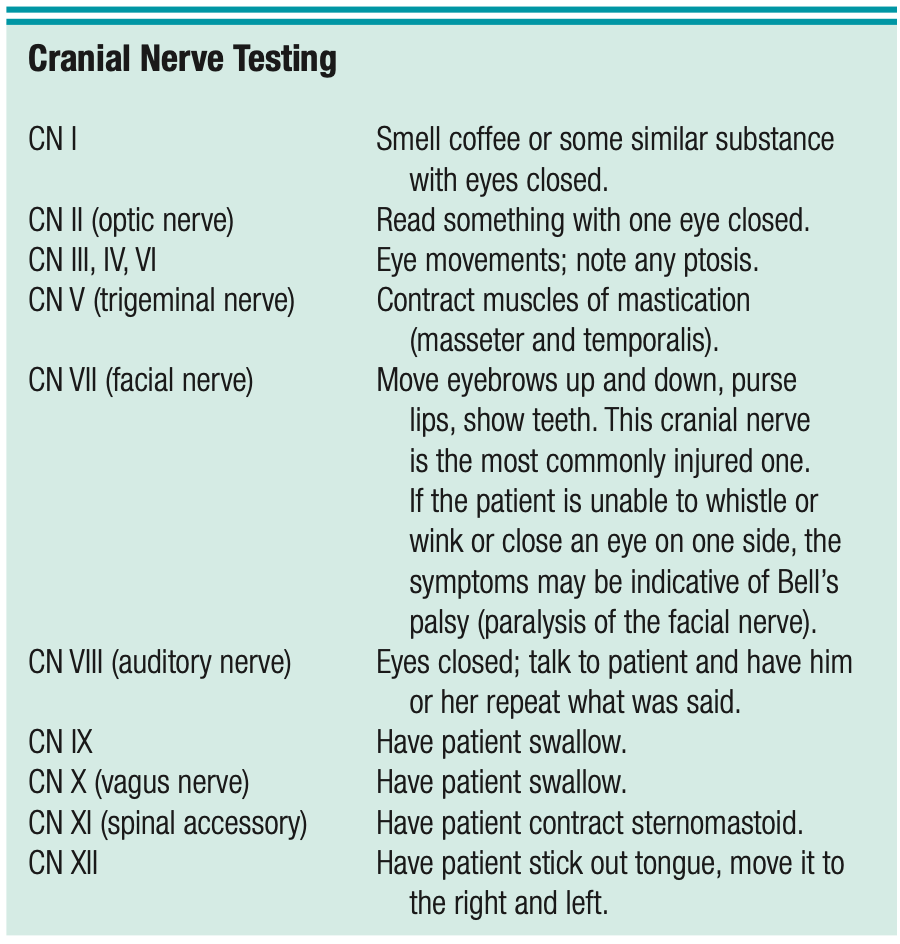
PROM
Endfeel
Tissue stretch ( opening & teeth contact
Bone to Bone ( closing )
______ : horizontal distance from the edge of the upper central incisors to the lower central incisors
If the lower teeth extend over the upper teeth, this malocclusion condition is called an _____.
______ is the vertical overlap of the teeth.
Overjet
Underbite
Overbite
MMT
Depression (opening)
Apply resistance at the chin with one hand or over the teeth using a rubber glove.
The other hand stabilizes the head by resting behind the head, neck, or over the forehead.
Lateral Deviation of the Jaw
One hand stabilizes the head above the TMJ.
The other hand is placed along the patient's jaw as they push against it with a slightly open mouth.
Closing of the Mouth (Elevation or Occlusion)
First method:
One hand stabilizes the back of the head or neck.
The other hand is placed under the chin of the slightly open mouth to resist movement.
Second method:
Use a rubber glove and place two fingers over the patient’s lower teeth (mandible) to resist movement.
FA
Chewing, swallowing, coughing, talking, and blowing.
If patient complains of pain while eating → bite down on a tongue depressor between the teeth in different positions
Biting down on one side stresses the TMJ on the opposite side.
FA → OMT
Research Diagnostic Criteria for Temporomandibular Disorders
TMJ Scale
Most Used
NO SPECIAL TESTS IN TMJ
HAHA
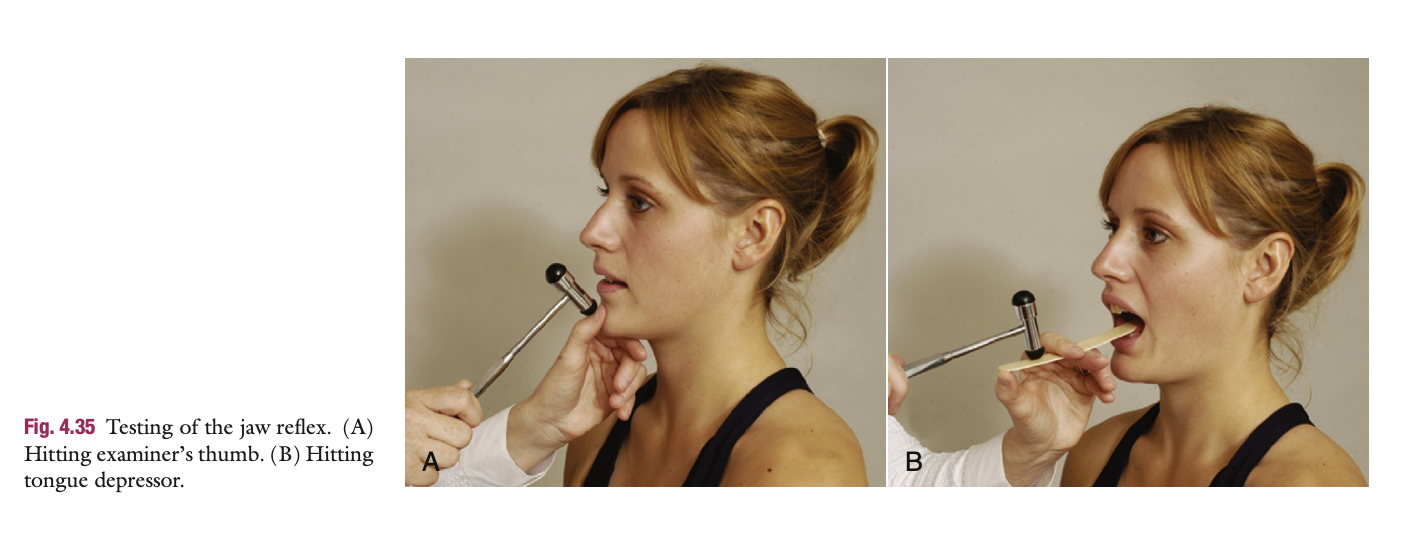
Jaw Reflex (TMJ Reflex)
Testing method:
The examiner places their thumb or finger on the patient's chin while the mouth is relaxed and open in the resting position.
The patient is asked to close their eyes to prevent tension from visual stimuli (e.g., seeing the hammer).
Execution:
The examiner taps the thumbnail with a neurological hammer to elicit the reflex.
Response:
The reflex causes the mouth to close, testing the function of cranial nerve V (CN V).
Alternative method:
Use a tongue depressor by holding it firmly against the bottom teeth.
While the patient relaxes their jaw muscles, the examiner taps the tongue depressor with the reflex hammer.
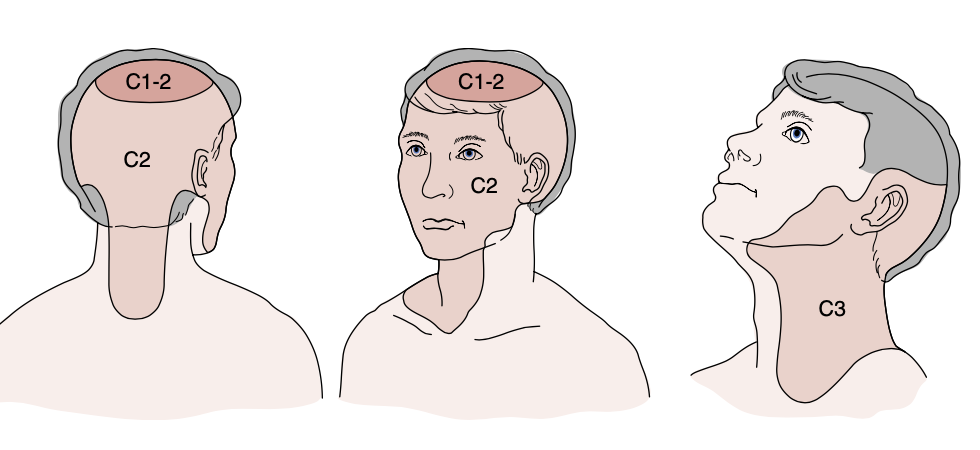
Dermatomes of Head
Temporomandibular Muscles and Referral of Pain
Pain may be referred from the TMJ to the teeth, neck, or head, and vice versa
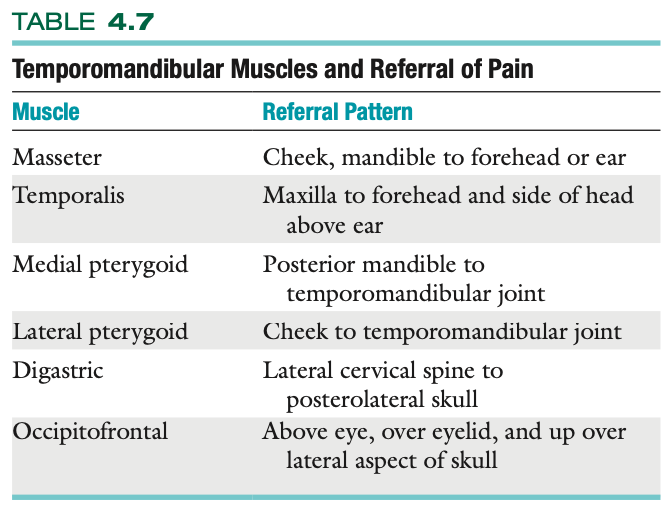
Palpation
Irritable joint characteristics:
Symptoms increase with minimal pressure (2 to 3 lb, approximately 1 kg).
Takes a longer time for sensations to return to baseline.
Nonirritable joint characteristics:
Symptoms only become evident with more pressure.
Shorter recovery time for sensations to return to baseline.
Palpation
Mandible
Normally, the parotid gland is not palpable.
Pathological conditions → feels “boggy” instead of the usual hard and bony texture.
Teeth
Hyoid Bone
ask patient to swallow
Thyroid Cartilage
In neutral position, the thyroid cartilage can be easily moved.
In neck extension, it feels tight, and crepitations may be felt.
The adjacent thyroid gland may also be palpated;
if abnormal or inflamed, it will be tender and enlarged.
Palpation
Mastoid Processes
Cervical Spine
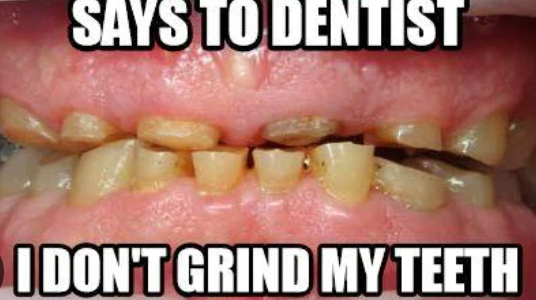
Keep Grinding